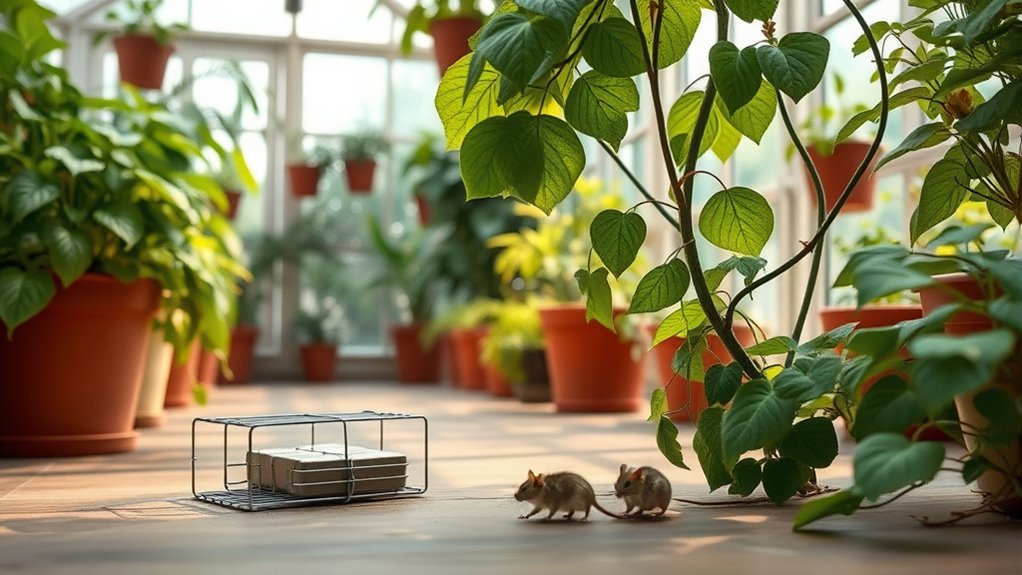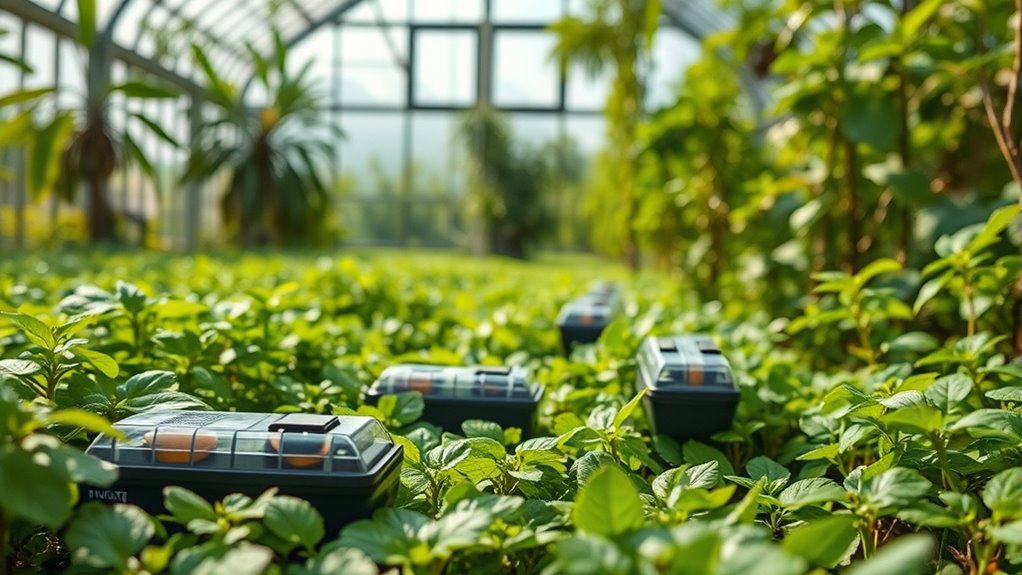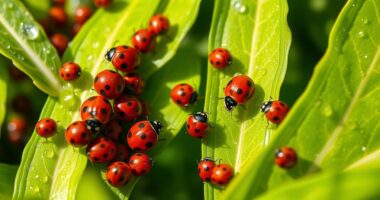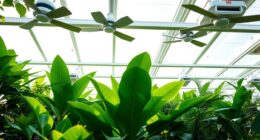To control rodents in and around your greenhouse, install bait stations along walls, near entry points, and around the perimeter, pairing them with snap or electronic traps in high-activity areas. Seal all tiny gaps, cracks, and vents to prevent new entries, and keep the area tidy by removing debris and potential nesting sites. Regularly check traps and bait stations, adjusting your approach if activity persists. Stick with these steps to safeguard your greenhouse—more tips await below.
Key Takeaways
- Seal all entry points and gaps to prevent rodents from entering the greenhouse environment.
- Use bait stations and traps strategically along walls and near signs of activity for effective control.
- Maintain cleanliness and sanitation to eliminate hiding spots and attractants for rodents.
- Regularly inspect and replace bait and traps, monitoring rodent activity closely.
- Implement an integrated approach combining sealing, trapping, sanitation, and ongoing monitoring for best results.

Dealing with rodents can quickly become a serious problem if you don’t take action. These pests can cause extensive damage to your greenhouse, contaminating plants, spreading disease, and undermining your efforts to maintain a healthy environment. The key to effective rodent control is to act quickly and employ a combination of strategies, starting with the right tools like bait stations and trapping methods. Bait stations are an essential part of your arsenal because they provide a controlled way to deliver poison or bait to rodents without putting other animals or children at risk. Place bait stations along walls, near entry points, and around the perimeter of your greenhouse, where rodents are most likely to travel. Guarantee they are secure and inaccessible to non-target animals, and check them regularly to replace bait as needed.
Act quickly with bait stations and traps to protect your greenhouse from rodent damage and contamination.
Trapping methods are equally important and give you immediate control over rodent populations. Snap traps, live traps, and electronic traps are common options, each suited for different situations. Snap traps are quick and effective, especially when baited with peanut butter or sunflower seeds. Position these traps along walls or in areas where you notice rodent activity—look for droppings, gnaw marks, or runways. Live traps allow you to catch rodents alive and release them far from your greenhouse, but you should check these frequently to prevent stress on the animals and avoid odor problems. Electronic traps deliver a quick, humane kill and are good for catching multiple rodents in a small space. Whichever trapping method you choose, always wear gloves when handling traps and rodents to avoid disease transmission.
In addition to bait stations and trapping methods, sealing entry points is essential. Rodents can squeeze through tiny gaps, so inspect your greenhouse thoroughly. Seal cracks, gaps around utility lines, and vents with steel wool or caulk to prevent new rodents from entering. Keep the area clean and free of clutter, as debris offers hiding spots and nesting sites. Regular monitoring is crucial; check traps daily and replace bait in bait stations regularly. If you notice rodent activity despite your efforts, it’s time to reassess your approach, possibly increasing trap numbers or switching bait types. Additionally, understanding rodent behavior can improve your control strategies by helping you predict their movement patterns and preferred hiding spots. Consistency is key—by maintaining a regular schedule of checks and adjustments, you’ll stay ahead of the problem.
Controlling rodents in and around your greenhouse takes effort, but using a strategic combination of bait stations and trapping methods, along with proper sealing and sanitation, will considerably reduce the risk. Acting swiftly and staying vigilant helps protect your plants, your investment, and your peace of mind.
Frequently Asked Questions
What Are the Most Common Rodent Species Found Near Greenhouses?
You’ll often find house mice and Norway rats near greenhouses. To effectively control them, you need to focus on rodent species identification and understand their habitat preferences. House mice prefer warm, sheltered areas inside structures, while Norway rats favor outdoor spaces with access to food and water. By recognizing these species and their habitats, you can implement targeted strategies to keep your greenhouse rodent-free.
How Do Rodents Damage Greenhouse Plants and Infrastructure?
Rodent damage to your greenhouse plants includes gnawing on stems, roots, and seeds, which stunts growth and reduces yields. They also chew through infrastructure like wiring, pipes, and insulation, leading to costly repairs and potential fire hazards. You might notice droppings and burrows, indicating infestations. To protect your greenhouse, it’s essential to implement effective rodent control measures that prevent these damages and safeguard your investment.
Are Natural Predators Effective for Rodent Control?
Natural predators can be part of biological control, but their effectiveness varies. You might introduce predators like owls or cats, but they often aren’t enough alone to control rodent populations effectively. Predator effectiveness depends on factors like habitat, rodent behavior, and predator presence. For reliable rodent control, combine natural predators with other methods, such as traps and barriers, to guarantee your greenhouse stays protected.
What Are the Health Risks of Rodents Around Greenhouses?
Rodents around your greenhouse pose a danger that’s more than just a nuisance—they can spread deadly diseases like leptospirosis and hantavirus. Their droppings and urine can contaminate your plants and tools, risking disease transmission to you and your staff. To prevent contamination, practice strict sanitation and secure food sources. Remember, a small rodent can cause a health crisis, so stay vigilant to protect your greenhouse’s integrity and your health.
How Can I Prevent Rodents From Entering Greenhouse Vents?
You can prevent rodents from entering greenhouse vents by installing vent screening that’s fine-mesh and durable. Make sure to regularly inspect and replace screens to keep holes or damage from forming. Additionally, strategically place traps near vents and other entry points to catch rodents before they get inside. Combining these methods creates a strong barrier, reducing the risk of rodent intrusion and protecting your greenhouse environment effectively.
Conclusion
By effectively controlling rodents, you protect your greenhouse’s delicate plants; yet, neglecting them invites destruction. Like a silent thief in the night, rodents can ruin months of hard work in moments. So, stay vigilant and proactive—your thriving crops depend on it. In this battle of coexistence, your quick action and careful prevention become the ultimate safeguard, turning potential chaos into controlled harmony. After all, in the fight for your greenhouse’s health, prevention is your best weapon.









